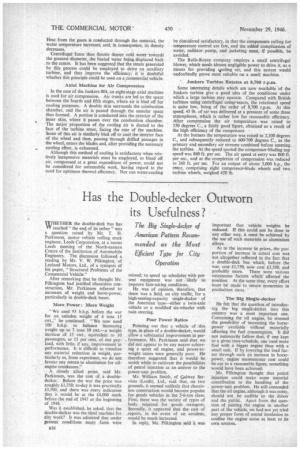Has the Double-decker. Outworn its Usefulness?
Page 54

If you've noticed an error in this article please click here to report it so we can fix it.
WHETHER the double-deck bus has VI' reached the end_ of its tether" was a question raised by Mr. T. H. Parkinson, motor vehicle rolling stock engineer, Leeds Corporation, at a recent Leeds meeting of the North-eastern Centre of the Institution of Automobile Engineers. The discussion followed a reading by Mr. V. W. Pilkington, of Leyland Motors, Ltd., of a synopsis of his paper, "Structural Problems of the Commercial Vehicle."
After remarking that he thought Mr. Pilkington had justified chassisless construction, Mr. Parkinson referred to increases of weight and horse-power, particularly in double-deck buses.
More Power : More Weight "We used 93 b.h.p, before the war for an unladen weight of 6 tons 15 cwt.," he continued. " We now need 100 b.h.p. to balance increasing weight up to 7 tons 10 ewt.—a weight increase of 15 cwt.. equivalent to 10 passengers, or 15 per cent. of our payload, with little, if any, improvement in performance. It is difficult to visualize any material reduction in weight, particularly as, from experience, we do not favour any return to aluminium for oilengine crankcases."
A closely allied point, said Mr. Parkinson, was the cast of, a doubledecker. Before the war the price was roughly £1,750; to-day it was practically £3,500, and there was every indication that it would be at the £4.000 mark before the end of 1947 or the beginning of 1948, Was it established, he asked, that the double-decker was the ideal machine for city work? It was admitted that under present conditions many fares were missed; to speed up schedules with present equipment was not -likely to improve fare-taking conditions.
He was of opinion, therefore, that there was a field, on city traffic, for a high-seating-capacity single-decker of the American type—either a twin-axle vehicle or a modified six-wheeler with twin steering.
Poor Power Ratios
Pointing out that a vehicle of this type, in place of a double-decker, would allow a substantial improvement in performance, Mr. Parkinson said that we did not appear to be any nearer achieving a quiet oil engine, and power-toweight ratios were generally poor. He therefore suggested that it would be worth while to cultivate the possibilities of petrol injection as an answer to the power-unit problem.
Mr. William Smith, of Galway Services (Leeds), Ltd., said that, on two grounds, it seemed unlikely that chassis. less construction would become popular for goods vehicles in the 5-6-ton class. First, there was the variety of types of body required for goods transport. Secondly, it appeared that the cost of repairs, in the event of an accident, would be much increased.
In reply, Mr. Pilkington said it was important that vehicle weights be reduced. If this could not be done in any other way, it must be achieved by the use of such materials as aluminium alloys.
As to the increase in prices, the proportion of increase in actual cost was not altogether reflected in the fact that a double-deck bus which, before the war, cost £1,750, now cost £3,500, and probably more. There were various extraneous factors which. affected the position. At the same time, every effort must be made to secure economies in production costs.
The Big Single-decker He felt That the question of introducing the big single-decker into this country was a most important one. Concerning the oil engine, he stressed the possibility of increasing the horsepower available Without materially affecting the fuel consumption. It did not necessarily follow that, if one kept to a given time-schedule, one used more fuel with a bigger engine than with a small unit. If by lowering the load factor through such an increase in horsepower, engine maintenance cost could be cut to a reasonable figure, something would have been achieved.
Mr. Pilkington thought that petrol injection could make some material contribution to the handling of the power-unit problem. He still contended that the oil engine, although it was noisy, should not be audible to the driver and the public. Apart from the question of putting the engine in another part of the vehicle, we had not yet tried any proper form of sound insulation to confine the engine noise at least to its own sources.
























































































